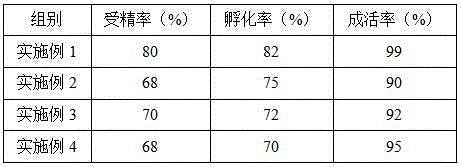Artificial breeding method for wild lampetra morii
A technology of artificial breeding and lamprey, which is applied in fish farming, application, climate change adaptation, etc., to achieve the effects of large-scale farming, large economic application value, and good breeding effect
- Summary
- Abstract
- Description
- Claims
- Application Information
AI Technical Summary
Problems solved by technology
Method used
Image
Examples
Embodiment 1
[0030] The artificial breeding of embodiment 1 wild northeast lamprey
[0031] 1. Select the breeding place of the Northeast Lamprey, which is the Shanding Lake in the waters of the Yalu River on the border between China and North Korea. During the breeding season of the Northeast Lamprey, put multiple grille fish cages into the depths of the water, lift the cages after 3 days, and obtain more than 100 fish cages. Vigorous sexually mature males and females.
[0032] 2. Use ice cubes, fish water, and air in a volume ratio of 1:2:2 to transport them to the artificial breeding site. The transportation time on the way shall not exceed 24 hours to prevent the lamprey from dying due to lack of oxygen or excessive temperature. The transported lampreys were reared in a constant temperature breeding box at 15°C with a photoperiod of 12h:12h. Because Northeastern lampreys do not eat when they are sexually mature, they only need to change fresh water twice a week.
[0033] 3. Artifi...
Embodiment 2
[0037] Embodiment 2 Artificial breeding of wild northeast lamprey
[0038] 1. Select the breeding place of the Northeast Lamprey, which is the Shanding Lake in the waters of the Yalu River on the border between China and North Korea. During the breeding season of the Northeast Lamprey, put multiple grille fish cages into the depths of the water, lift the cages after 3 days, and obtain more than 100 fish cages. Vigorous sexually mature males and females.
[0039] 2. Use ice cubes, fish water, and air in a volume ratio of 1:2:2 to transport them to the artificial breeding site. The transportation time on the way shall not exceed 24 hours to prevent the lamprey from dying due to lack of oxygen or excessive temperature. The transported lampreys were reared in a constant temperature breeding box at 15°C with a photoperiod of 12h:12h. Because Northeastern lampreys do not eat when they are sexually mature, they only need to change fresh water twice a week.
[0040]3. Artificial ...
Embodiment 3
[0044] Embodiment 3 Artificial breeding of wild northeast lamprey
[0045] 1. Select the breeding place of the Northeast Lamprey, which is the Shanding Lake in the waters of the Yalu River on the border between China and North Korea. During the breeding season of the Northeast Lamprey, put multiple grille fish cages into the depths of the water, lift the cages after 3 days, and obtain more than 100 fish cages. Vigorous sexually mature males and females.
[0046] 2. Use ice cubes, fish water, and air in a volume ratio of 1:2:2 to transport them to the artificial breeding site. The transportation time on the way shall not exceed 24 hours to prevent the lamprey from dying due to lack of oxygen or excessive temperature. The transported lampreys were reared in a constant temperature breeding box at 15°C with a photoperiod of 12h:12h. Because Northeastern lampreys do not eat when they are sexually mature, they only need to change fresh water twice a week.
[0047] 3. Artificial...
PUM
 Login to View More
Login to View More Abstract
Description
Claims
Application Information
 Login to View More
Login to View More - R&D
- Intellectual Property
- Life Sciences
- Materials
- Tech Scout
- Unparalleled Data Quality
- Higher Quality Content
- 60% Fewer Hallucinations
Browse by: Latest US Patents, China's latest patents, Technical Efficacy Thesaurus, Application Domain, Technology Topic, Popular Technical Reports.
© 2025 PatSnap. All rights reserved.Legal|Privacy policy|Modern Slavery Act Transparency Statement|Sitemap|About US| Contact US: help@patsnap.com

